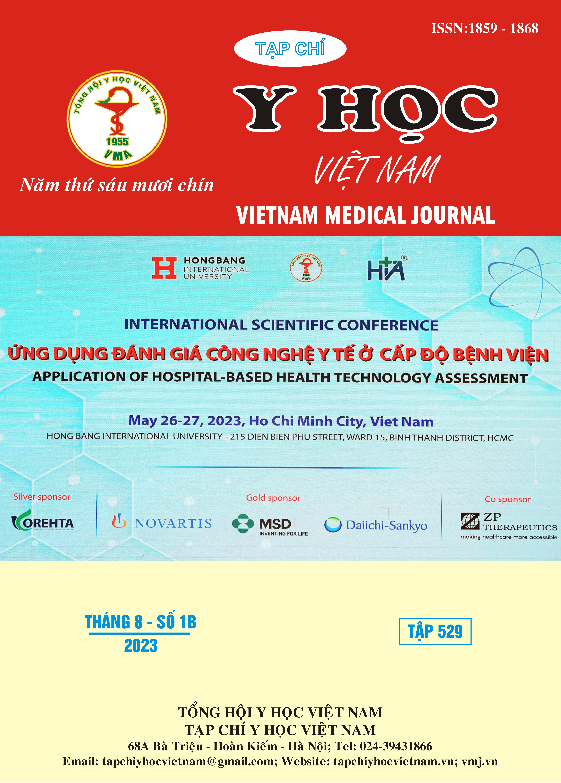MÔ HÌNH BỆNH TẬT CHUYỂN TUYẾN CỦA BỆNH NHÂN SƠ SINH TẠI BỆNH VIỆN NHI THANH HÓA GIAI ĐOẠN 2017 - 2022
Nội dung chính của bài viết
Tóm tắt
Đặt vấn đề: Trẻ sơ sinh là những trẻ em được tính từ sau sinh tới 28 ngày đầu của tuổi, là giai đoạn nhạy cảm với rất nhiều nguy cơ bệnh lý tiềm tàng. Việc khảo sát mô hình bệnh tật chuyển tuyến sơ sinh là cần thiết. Nghiên cứu này được tiến hành với hai mục tiêu: 1) Xác định tỷ lệ chuyển tuyến trung ương của bệnh nhân sơ sinh khám, chữa bệnh tại Bệnh viện Nhi Thanh Hóa trong các năm từ 2017-2021; và 2) Khảo sát mô hình bệnh tật chuyển tuyến trung ương của bệnh nhân sơ sinh tại Bệnh viện Nhi Thanh Hóa giai đoạn 2017-2021. Phương pháp nghiên cứu: Thiết kế nghiên cứu cắt ngang được sử dụng với số liệu được thu thập hồi cứu từ hồ sơ bệnh án từ khoa Sơ sinh và khoa Hồi sức tích cực sơ sinh, Bệnh viện Nhi Thanh Hóa trong thời gian từ 01/01/2017 – 31/12/2021. Các biến số về thông tin cá nhân của trẻ và các bệnh lý chuyển tuyến được thu thập. Kết quả: Trong số 955 bệnh nhân chuyển tuyến sơ sinh, tỷ lệ chuyển tuyến trung bình các bệnh nhân sơ sinh là 4,93%, trong đó tỷ lệ chuyển viện của khoa HSTCSS (12,79%) cao hơn khoa Sơ sinh (1,69%). Tỷ lệ bệnh nhân chuyển tuyến cao nhất năm 2018, thấp nhất năm 2017, tỷ lệ chuyển năm 2021 giảm so với 3 năm trước 2018, 2019, 2020. Các bệnh nhân chuyển tuyến chủ yếu là dưới 7 ngày tuổi và là bệnh nhân nam. Về mô hình bệnh nhân chuyển tuyến sơ sinh, bệnh nhân chuyển viện vì nhiều bệnh lý khác nhau, ngoài các bệnh lý của sơ sinh còn có sự liên quan của các chuyên khoa khác. Các nhóm bệnh chuyển viện phổ biến nhất của bệnh nhân sơ sinh lần lượt là đẻ non, suy hô hấp, và bệnh lý tim mạch. Kết luận: Cần tăng cường chất lượng chăm sóc bệnh nhân đẻ non tại Bệnh viện. Để hạn chế số lượng bệnh nhân đẻ non Bệnh viện cần đảm bảo điều kiện chăm sóc vô khuẩn, đảm bảo kiểm soát nhiễm khuẩn, nguồn nước được đảm bảo, các trang thiết bị được kiểm tra, bảo dưỡng, hiệu chuẩn định kỳ. Bên cạnh đó, cần giám sát việc tuân thủ các quy trình chuyên môn tốt hơn để hạn chế tối đa nguy cơ nhiễm khuẩn cho bệnh nhân, đặc biệt đối tượng non tháng. Ngoài ra, để hạn chế bệnh nhân sơ sinh chuyển tuyến còn cần sự phát triển chung của nhiều chuyên khoa trong Bệnh việntrong quá trình điều trị bệnh nhân.
Chi tiết bài viết
Từ khóa
Sơ sinh, chuyển tuyến, bệnh lý sơ sinh, trẻ sơ sinh
Tài liệu tham khảo
2. Bộ Y tế (2014), Thông tư số 37/2014/TT-BYT ngày 17/11/2014 Hướng dẫn đăng ký khám bệnh, chữa bệnh ban đầu và chuyển tuyến khám bệnh, chữa bệnh bảo hiểm y tế, chủ biên.
3. Bộ Y tế (2015), Báo cáo chung tổng quan ngành Y tế năm 2015, chủ biên.
4. Hoàng Trọng Kim, Bạch Văn Cam và Đỗ Văn Dũng (2005), "Tình hình chuyển viện sơ sinh từ các cơ sở y tế đến khoa cấp cứu Bệnh viện Nhi đồng 1 từ tháng 3/2003 – 2/2004", Tạp chí y học thành phố Hồ Chí Minh. 9, tr. 22-28.
5. Hoàng Trọng Quý (2016), "Nghiên cứu mô hình bệnh tật giai đoạn sơ sinh tại Bệnh viện đa khoa Phú Vang năm 2016", Đề tài nghiên cứu khoa học cấp cơ sở.
6. Lê Nam Trà, Cao Ngọc Thành và Nguyễn Thị Kiều Nhi (2005), "Nghiên cứu mô hình bệnh tật và tỷ suất tử vong giai đoạn sơ sinh sớm tại khoa sản bệnh viện trung ương Huế", 5PB, tr. 32-38.
7. Lê Quang Cường và các cộng sự. (2011), Nghiên cứu thực trạng quá tải, dưới tải của hệ thống bệnh viện các tuyến và đề xuất giải pháp khắc phục, Cục Quản lý Khám chữa bệnh, Bộ Y tế.
8. Phạm Thị Xuân Tú Trần Đình Long (2013), Đặc điểm, cách chăm sóc trẻ sơ sinh đủ tháng và thiếu tháng, Bài giảng Nhi khoa tập 1, ed, Nhà xuất bản Y học Hà Nội,, Đại học Y Hà Nội.


